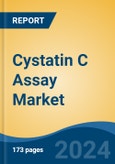Enzyme-Linked Immunosorbent Assay (ELISA) is the fastest growing segment, North America is the largest market globally
Speak directly to the analyst to clarify any post sales queries you may have.
10% Free customizationThis report comes with 10% free customization, enabling you to add data that meets your specific business needs.
Key Market Drivers
The market for Cystatin C assays is significantly propelled by the recognized superiority of Cystatin C as an early and accurate renal biomarker. This protein offers a more reliable and precise assessment of glomerular filtration rate because its levels are largely independent of confounding factors such as muscle mass, age, sex, and diet, which often influence creatinine measurements. This intrinsic biological advantage positions Cystatin C as a preferred biomarker for detecting subtle changes in kidney function and facilitating earlier diagnosis. For instance, according to a study published in the Journal of Clinical and Diagnostic Research on March 1, 2024, regression analysis indicated a tighter distribution of results for cystatin C, with an R² value of 0.67, compared to 0.64 for creatinine, demonstrating its superior predictive ability for GFR.Key Market Challenges
The elevated cost of Cystatin C reagents and associated testing presents a significant challenge to the widespread growth of the Global Cystatin C Assay Market. This comparative expense, particularly when benchmarked against established and more affordable creatinine assays, directly influences procurement decisions within diverse healthcare systems. The financial disparity strains operational budgets for clinical laboratories, making the adoption of these advanced diagnostics a subject of intense scrutiny regarding cost-effectiveness. Consequently, despite the recognized clinical benefits of Cystatin C assays for more precise renal function assessment, their higher cost hinders broader integration into routine diagnostic panels.Key Market Trends
The growing demand for automated assay systems represents a significant market trend, driven by the need for enhanced efficiency, reduced manual errors, and increased throughput in clinical laboratories. Automation streamlines complex workflows, from sample handling to result analysis, which is critical for managing high testing volumes and addressing staffing shortages. For instance, the College of American Pathologists, in its 2024 Surveys and Anatomic Pathology Education Programs document, highlighted that it offers more than 700 proficiency testing programs, reflecting the extensive scope of quality assurance in laboratory diagnostics that benefits from automated processes.Key Market Players Profiled:
- F. Hoffmann-La Roche Ltd
- Abbott Laboratories Inc.
- Thermo Fisher Scientific Inc.
- Siemens Healthineers AG
- Bio-Techne
- Agilent Technologies, Inc
- Gentian Diagnostics ASA
- Abcam Limited
- Getein Biotech, Inc
- Sino Biological, Inc
Report Scope:
In this report, the Global Cystatin C Assay Market has been segmented into the following categories:By Product:
- Analyzers
- Kits
- Reagents
By Method:
- Enzyme-Linked Immunosorbent Assay (ELISA)
- Particle-Enhanced Turbidimetric Immunoassay (PETIA)
- Particle-enhanced Nephelometric Immunoassay (PENIA)
- Chemiluminescent immunoassay (CLIA)
- Immunofluorescence assay (IFA)
- Others
By Sample Type:
- Blood
- Urine
By Application:
- Diagnostics
- Research
By Region:
- North America
- Europe
- Asia Pacific
- South America
- Middle East & Africa
Competitive Landscape
Company Profiles: Detailed analysis of the major companies present in the Global Cystatin C Assay Market.Available Customizations:
With the given market data, the publisher offers customizations according to a company's specific needs. The following customization options are available for the report:- Detailed analysis and profiling of additional market players (up to five).
This product will be delivered within 1-3 business days.
Table of Contents
Companies Mentioned
- F. Hoffmann-La Roche Ltd
- Abbott Laboratories Inc.
- Thermo Fisher Scientific Inc.
- Siemens Healthineers AG
- Bio-Techne
- Agilent Technologies, Inc
- Gentian Diagnostics ASA
- Abcam Limited
- Getein Biotech, Inc
- Sino Biological, Inc
Table Information
| Report Attribute | Details |
|---|---|
| No. of Pages | 180 |
| Published | November 2025 |
| Forecast Period | 2024 - 2030 |
| Estimated Market Value ( USD | $ 385.54 Million |
| Forecasted Market Value ( USD | $ 552.49 Million |
| Compound Annual Growth Rate | 6.1% |
| Regions Covered | Global |
| No. of Companies Mentioned | 10 |









